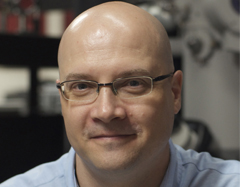August 06, 2018
 Why look at a picture if you can watch a video? Until just more than a decade ago, materials scientists had only snapshots of materials on an ultrasmall scale. They had diffraction to send electrons through a material and watch what happens to its structure, like ripples scattering off pebbles in a pond. They could use transmission electron microscopes to take images of atoms. Now, ultrafast electron microscopy (UEM) allows scientists to take hundreds, or even thousands, of images that show extraordinarily fast nanoscale processes essentially happening in real time, such as how energy moves through solids.
Why look at a picture if you can watch a video? Until just more than a decade ago, materials scientists had only snapshots of materials on an ultrasmall scale. They had diffraction to send electrons through a material and watch what happens to its structure, like ripples scattering off pebbles in a pond. They could use transmission electron microscopes to take images of atoms. Now, ultrafast electron microscopy (UEM) allows scientists to take hundreds, or even thousands, of images that show extraordinarily fast nanoscale processes essentially happening in real time, such as how energy moves through solids.
Dave Flannigan, an associate professor and director of Undergraduate Studies for Materials Science and Engineering at University of Minnesota, is the recipient of Sigma Xi’s 2018 Young Investigator Award for his contributions to UEM. Part of his award is an opportunity to speak about his research at the Society’s Annual Meeting, which he will do on October 27. The award, which is available to active Sigma Xi members within 10 years of his or her highest earned degree at the time of nomination, also comes a $5,000 honorarium.
Flannigan spent his postdoctoral days under the guidance of Nobel laureate and UEM pioneer Ahmed Zewail at California Institute of Technology. Flannigan was the first to use UEM to image the dynamics of materials that had molecules as their constituents. He also co-developed a new imaging technique called photon-induced near-field electron microscopy that couples photons with electrons to record transient electric fields around nanoscale materials, and he was the first to extend this method to organic and biological materials. He later helped establish the first commercially available ultrafast electron microscope at Minnesota.
Flannigan is now using UEM to fill in fundamental gaps in our understanding of materials science. All materials have defects and impurities, and he hopes that one day UEM will help scientists use them as an advantage, such as to better control heat dissipation on a computer chip to improve computing speed.